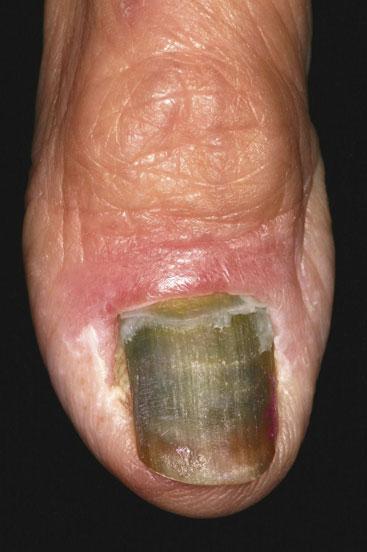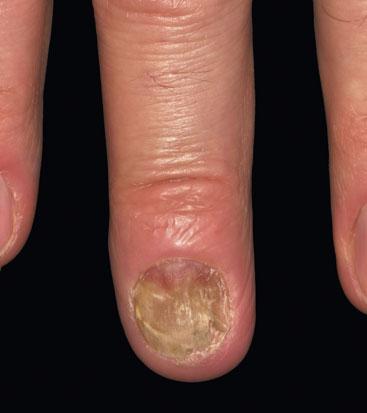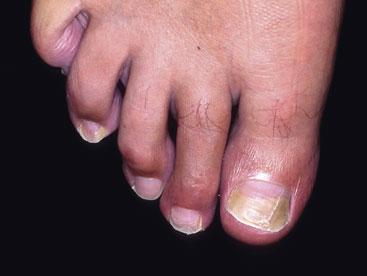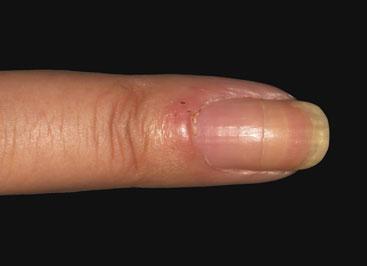Finger and toenails
Dr Mike Wyndham is a GP in a suburban practice in Edgware Middlesex. He has always been a keen phot...
Dr Mike Wyndham is a GP in a suburban practice in Edgware Middlesex. He has always been a keen photographer, and has been taking medical photographs for more than 25 years. He has been a regular contributor to the GP press and his work has also appeared in the British Medical Journal, The Pharmaceutical Journal and various medical text books
Finger and toenails can offer warning signs of a number of conditions - including serious diseases affecting the liver, lungs, heart and immune system. They can also provide a record of past trauma and systemic illness, hormone or iron deficiencies - and of course, can develop fungal infections which can be hard to treat. Whatever the presentation, it may be worth looking at your patient's nails for diagnostic clues.
BLOOD UNDER THE NAIL
It is easy to diagnose trauma as a cause of nail change when there is a history of injury. Where there is a large amount of blood, there may be a significant amount of pain requiring a trephine of the nail to release the pressure created by the trapped blood. Medicine is often about excluding causes for problems and the most important one in this situation is a subungual melanoma. Observation with a magnifying instrument may help to identify a red colour confirming blood as shown here. It is reassuring if there is area of normal nail between the pigment and the nail fold. If there is pigmentation of the periungual skin, (also known as Hutchinson sign) be suspicious of melanoma

PSORIATIC NAIL
Only about 5% people have psoriasis of the nails only. Thimble pitting is the commonest change, and onycholysis - where the nail plate lifts of the nail bed - is the next most common change. Discolouration of the nails may occur and is described as a pink colour. The example here appeared a more brown colour with the nail returning to normal when this man had treatment for his psoriatic arthropathy with methotrexate. Toenails may be affected with thickening. Arthopathy is more likely to develop when there is nail change.

PSEUDOMONAS NAIL INFECTION
Pseudomonas is an important organism when it comes to chronic lung disease such as cystic fibrosis. It may be a cause of outer ear infection, colonise urinary catheters and be found in the moist environment of respiratory equipment. The organism can produce a pigment called pyocyanin, which creates a green colour. The infection may develop where the nail has become onycholytic (lifting off from the nail bed) and develops on the undersurface of a normal thickness nail. The nail may be infected simultaneously with candida, which will require attention. Various treatments are recommended, such as 15% sodium sulfacetamide nail paint.

CANDIDA NAIL INFECTION
Candida may cause infection of the nail fold, which will result in it becoming thickened and raised. This is more likely to develop if the hands are in a wet environment. When the nail is infected, it may become discoloured and dystrophic in appearance. To treat the infection of the nailfold, a cream such as miconazole can be used. For the nail itself, oral itraconazole is used, prescribed as pulsed therapy (200mg twice a day for 1 week, with subsequent courses after a further 21 days). Fingernail infections require two pulsed courses, three for toenail infections.

ONYCHOMYCOSIS (SUCCESSFULLY TREATED)
Fungal infection of the toenails is common. Generally the nail becomes thickened and hard to cut. The infection commences at the distal margin and will ultimately cause the whole nail to change if left untreated. Onycholysis may develop. Fungal infection of the skin of the feet may be present too (tinea pedis). Elderly people may develop thickened nails as a product of age rather than fungal infection. It is important to get a nail culture. In this case, the problem was treated with terbinafine and the normal nail has started to grow through.

NAILS AFFECTED BY CHEMOTHERAPY
Nail changes may occur with chemotherapy. These may include reduced or increased pigmentation (e.g. turning yellow), onycholysis, development of a beau line or even falling out altogether.

BEAU LINE
A beau line is a transverse groove across the nail. It is caused by the nail ceasing to grow for a period of time. The cause of this is usually a serious illness such as pneumonia, or myocardial infarction. It usually takes about 6 months to grow out and a ridge half way up the nail would suggest the 'insult' occurred 3 months previously.

Related articles
View all Articles